Oracle Commerce is the industry’s top-ranked commerce solution that powers the world’s best brands, and delivers a consistent, personalized cross-channel customer experience. Oracle Commerce offers a complete commerce software platform that enables you to deliver a personalized customer buying experience across all customer touchpoints, including the web, contact center, mobile devices, social media, physical stores, and more.

Oracle Commerce is a fully integrated e-commerce application suite that streamlines and personalizes the way businesses interact and engage with their customers. It’s not just the buying process; Oracle Commerce covers other touch points of engagement with the customers. By using high-end capabilities, businesses can use the application interface and architecture in a very flexible and scalable way.
Merchants and retailers can use Oracle Commerce’s platform to implement fully functional web stores, social or commercial sites, and mobile applications. It caters to both B2C and B2B brands to widen their product functionality, giving them full control over the use and deployment of tools.
Oracle Commerce Platform:
Integrated with the modern architecture framework, this platform enables businesses to offer customized as well as generic capabilities per their requirements. This platform offers scalability and flexibility for all medium or large sized businesses. Whether the businesses or merchants are looking out to set high-end shopping carts or product catalogs, Oracle Commerce will personalize the capabilities in the most targeted way. So, the end result would not just be lucrative e-commerce functionalities, but also the personalized and unified customer experiences and simplified management.
Oracle Commerce Experience Manager:
Staying digital requires battling at all front lines be it social media, websites or search engines. Through experience manager, the business can develop back-end and front-end capabilities which are imperative for enhancing the user experiences. It also enables businesses to generate leads by using the feature of real time clicks and converting these leads into prospects within no time. The omni-channel experience is enhanced by the rich layouts, merchandising options, personalizing and navigational capabilities and other over-arching social media activities. So, businesses get to keep a control over how their e-commerce platform operates and engages with the customers.
Benefits
Robust and user-friendly: The resounding opinion is that OCC is easy to use, with minimal-to-no need to overwhelm your support staff. It features functionalities and page designs with limited programming and development requirements on the back end. The dashboards are easily customizable, and the search tool is one of the best in the industry. If you’re not a tech expert, OCC has you covered.
International capabilities: Do you need several multinational sites with multilingual capabilities? That’s no problem with OCC—you can quickly build as many online shops as you need, with language capabilities to address a global target market.
Ability to optimize conversion rates: To which items will your shoppers respond best? You can find out by conducting A/B split tests, and OCC makes it easy—with no programming requirements. You can easily test for the best marketing results, and the OCC system automatically implements your winning variable—live and in real time.
Accessible through multiple channels: OCC is compatible for viewing by desktop, laptop, smartphone and mobile device. More and more, the world runs on mobile—and with OCC, you can make it easier and more convenient for shoppers to visit your storefront.
Easy transition: If you’re currently running on an on-premise hosted platform, Oracle has designed its platform to make transition to the cloud as hassle-free as possible.
Excellent customer service: If you have a question or need support, the OCC service team is available around the clock by email or phone.
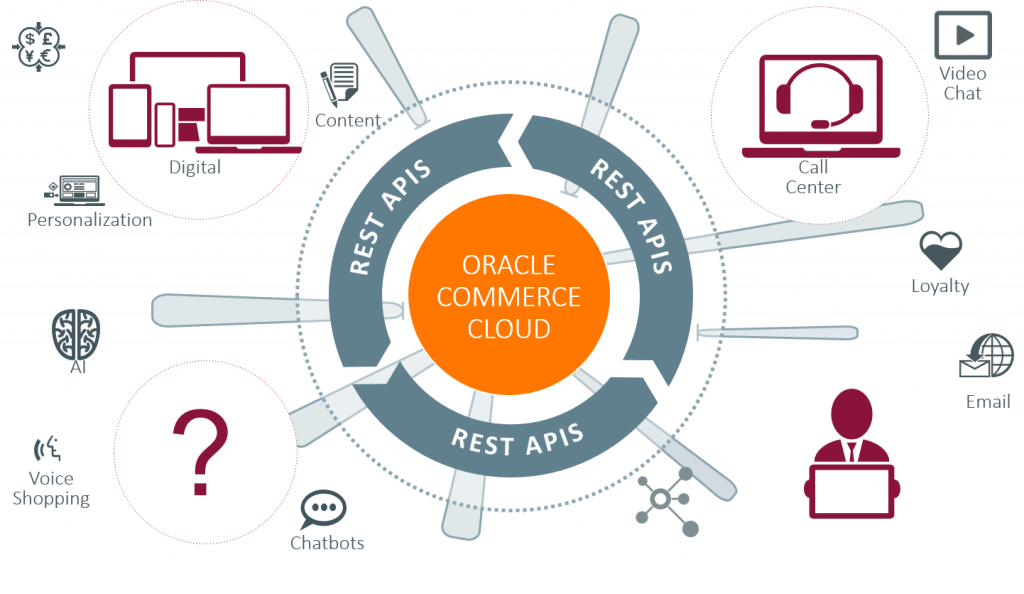
Features
This section lists some of the key capabilities that are available with or supported by Commerce Cloud and indicates where you can find more information about them. With Commerce Cloud, you can perform the following operations related to managing an eCommerce storefront:
Customize the templates and layouts that determine how your store looks.
Your storefront is made up of layouts, which represent the different page types that can appear, such as product details, checkout, and order confirmation. The default layouts act as templates, and you use them to design, adjust, and preview your pages before publishing live.
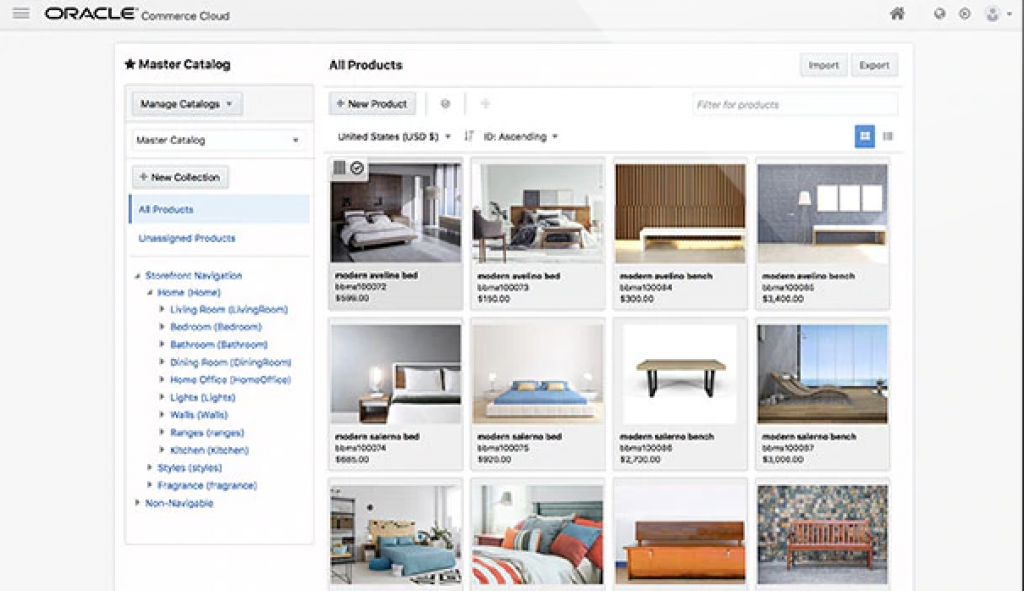
Layouts contain a set of design tools, known as widgets that define the structure of your web store pages. Several widgets are themselves made up of configurable sub-component elements. Widgets contain within them the specific UI functionality to which they relate. For example, the Order Confirmation layout contains information on items ordered, prices, shipping address, and so on. Each layout’s widgets combine to form the overall page layout. Accessible via a component library, widgets can be added, removed, cloned, and customized.
Manage your catalogs, inventory, and pricing.
A catalog organizes your products, SKUs, and collections in a hierarchy that reflects the way users will navigate to them on your store. Your store contains only one catalog, but that catalog can contain any number of collections, which can contain any number of products and associated SKUs.
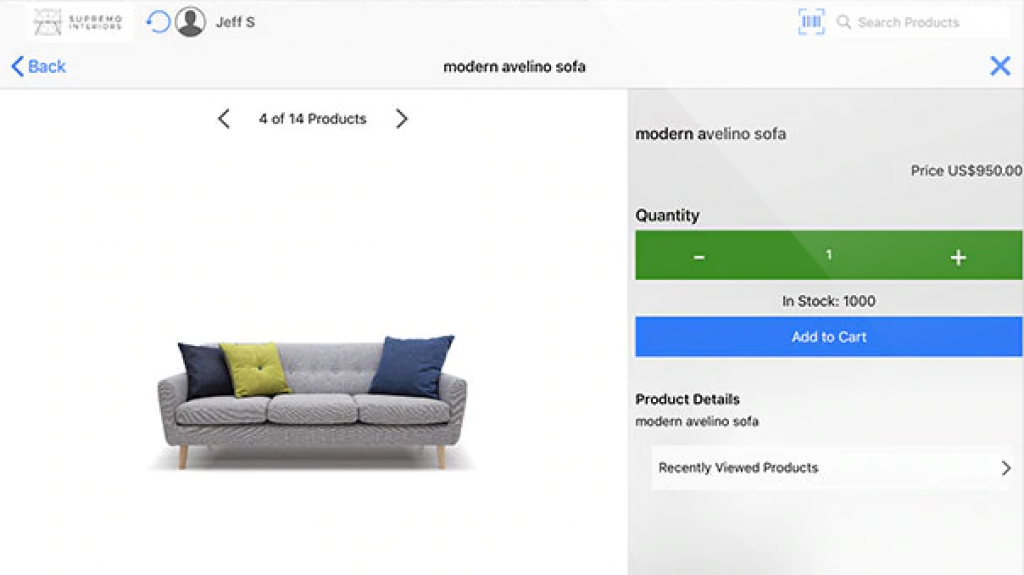
A price group is a set of price lists (list price, sale price, and shipping surcharge), in a specific currency, for the products, SKUs, and shipping surcharges in a catalog. Price groups let you price catalog items (products, SKUs, and shipping surcharges) in multiple currencies so a shopper can select from a list of currencies your store supports and see those prices on your store.
Translate your catalogs and content into different languages and display prices in locale-appropriate currencies.
You can translate your catalog and store content into multiple languages so a shopper can automatically see your store in the language specified by her browser’s locale. A shopper can also manually select a language from a list of languages your store supports.
Provide advanced search tools for your site.
The Search page in the administration interface contains a read-only table that lists all properties that are searchable or serve as facets. You can use the Search page to configure the searchable field rankings that determine how searches work in your store.
The Search page also lets you create synonyms for shoppers’ search terms in a thesaurus or create keyword redirects for search terms. You can see the Search page only if you have been assigned the Admin or Search role.
Manage your Search Engine Optimization (SEO) strategy.
Search Engine Optimization (SEO) is a term used to describe a variety of techniques for making your store’s pages more accessible to web spiders (also known as web crawlers or robots), the scripts used by Internet search engines to crawl the Web to gather pages for indexing.

The goal of SEO is to increase the ranking of the indexed pages in search results and to make sure shoppers view the pages you want them to see when they search. The topics in this section describe several SEO techniques and the built-in tools that Commerce Cloud provides for implementing them.
Offer discounts and promotions.
Promotions allow you to offer discounts on specific products or groups of products. For example, you might decide to promote a range of products for Mother’s Day by highlighting them with an image on your site’s “Welcome!” page and offering a 10 percent discount if customers order them by a specific date. You can also use the Commerce Cloud Admin API to programmatically create a number of promotion types that are not available in the UI.
Personalize storefront content for different shoppers.
Defining an audience allows you to target content to certain groups of shoppers. You define an audience by creating a set of rules based on attributes of the shopper profile. The audience can then be used by other tools for personalizing the shopper’s experience.
Offer product recommendations and display related products.
Commerce Cloud includes a Product Recommendations widget you can use to provide automated, personalized product recommendations to each shopper. Using your catalog, click-stream data, and historical shopping information, the widget offers a unique, predictive approach to providing individualized product recommendations to each shopper during every session.
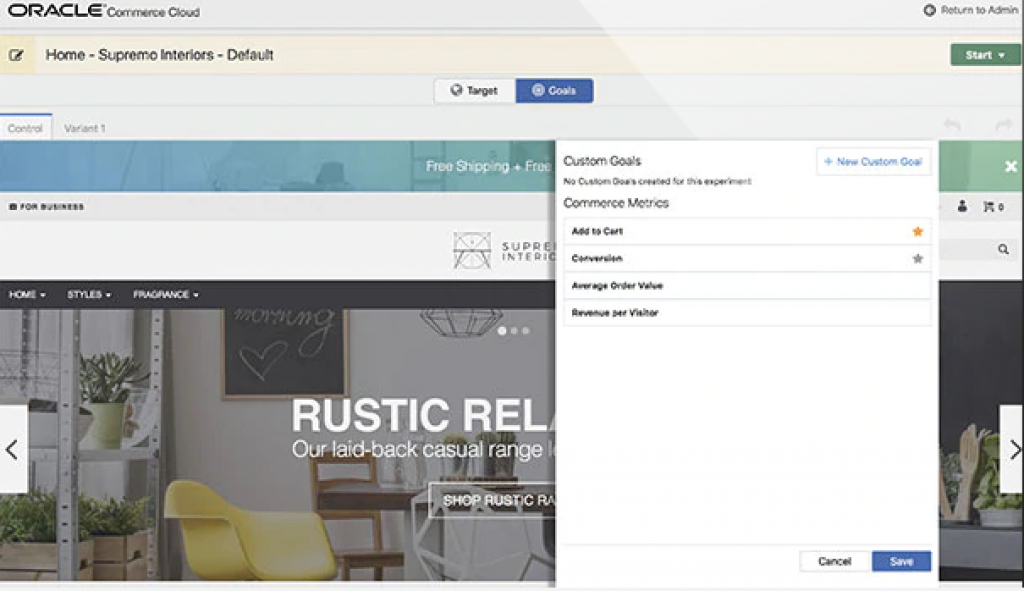
The widget can be placed in any layout, and the same widget instance can be shared over as many pages as necessary to provide recommendations to your shoppers.
Use a product’s Related Products tab to select products to display in the Related Products widget on the Product layout and specify the order in which the related products appear.
Use the Details tab to configure how the products look in the widget, for example, whether names and prices are displayed for related products.
Manage transactional emails between the store and your shoppers.
Commerce Cloud lets you configure and automatically send different types of email notifications to customers. In order to send email to customers, you must have an account with an email service.
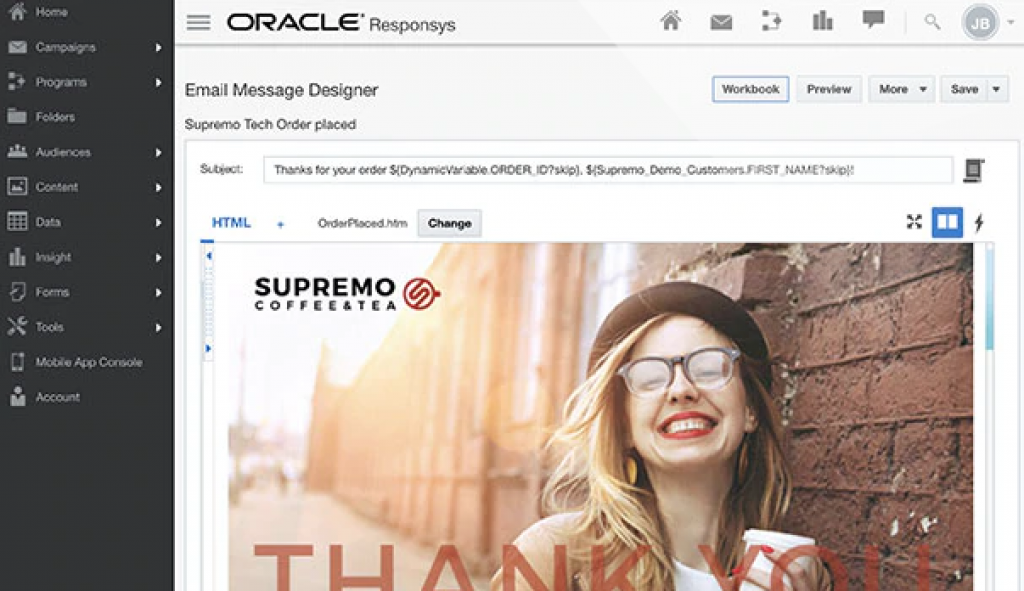
Support wish lists with links to social networks.
Wish lists provide shoppers with the following:
- A way to create and manage a list of products they are considering buying. Included is the ability to save items in wish lists and purchase easily from them later.
- The ability to create and manage multiple wish lists so shoppers can better organize items they may want to purchase.
- The ability to share their wish lists.
- The opportunity for shoppers to add comments to items in their wish lists.
- A social experience where shoppers can receive feedback and suggestions from friends and family members they invite to their wish lists.
- Email notifications for key wish list-related activities.
Integrate with payment and tax processors.
Commerce Cloud includes several built-in integrations with payment gateways that let your store accept credit cards, debit cards, gift cards, and PayPal payments. In addition to the built-in integrations you can use tools that Commerce Cloud provides to create custom integrations with other payment gateways.
If you run multiple sites within a single instance of Commerce Cloud, each site can use different payment methods. The set of payment methods you configure are available to every site, but you can assign a different subset of them to each site. Each new site you create automatically inherits its payment methods from the default site, though you can change them on the Payment Processing page.
Commerce Cloud integrates with both Avalara AvaTax and Vertex O Series to automatically calculate sales tax in the shopping cart. Commerce Cloud uses the Avalara integration by default, but you can easily switch to the Vertex integration. If you process taxes with a different tax processor, you can use webhooks to integrate with your tax processor so it calculates taxes in the shopping cart. You can also disable all tax processor integration if you use an OMS or other external service to handle tax processing.
Some shoppers may have tax exempt status for certain purchases. If you run multiple sites within a single instance of Commerce Cloud, these sites share the same tax processor settings, but each site can have its own ship-from address. If you are using a loyalty program, you can configure tax processing to convert to and from loyalty points currency.
Pricing
Oracle Retail Consulting–Commerce has an accelerator program for implementing a fully functional ecommerce site on Oracle Commerce Cloud at a fixed price of $150,000, and with a start-to-launch implementation period of three months. The program has been designed for:
- Mid-market direct-to-consumer brands that want to move from an on-premise or conventional hosted solution to Oracle Commerce Cloud in a cost-effective and expedient fashion, yet with the quality and backing of Oracle
- Up-market brands interested in getting a new brand on the cloud quickly
Billing Models for Commerce Cloud
- Oracle Commerce Cloud has flexible subscription pricing models to serve customer needs.
- Page views for predictable, transparent pricing: Fees can be based on annual page views, sized to historic performance and growth goals, helping customers know exactly what they will pay.
- Revenue share for shared success if desired: Fees can be based on a negotiated percentage of GMV.
Competitors
Other vendors are developing similar platforms to create seamless customer experience and integrate customer information. Salesforce has its Commerce Cloud and SAP has the Beyond CRM/Hybris platform.
Salesforce Commerce Cloud
Salesforce Commerce Cloud is a highly scalable, cloud-based software-as-a-service (SaaS) ecommerce solution. It offers best-in-class features and functionality developed and refined over many years to provide a highly optimised ecommerce experience. It combines functionalities for e-commerce, online store and mobile-first POS, order management as well as predictive intelligence under one platform. Its features are organized into three categories — experience, operations, and intelligence.
SAP CRM
SAP CRM is a customer relationship and engagement platform built to greatly enhance your engagement capabilities and enable you to provide smooth and personalized customer experiences at every opportunity and across multiple channels.
With SAP CRM, you can choose to have the software deployed on the cloud or on-premise based on the implementation your business requires. Both options extend their functionality to smartphones and tablets. The software improves your sales and marketing as you discover new insights that are covered deep under tons of customer and social information. You are able to boost customer engagement, drive sales, and streamline order-to-cash processes among others.
Summing Up
Oracle Commerce Platform is Oracle’s omnichannel technology to create a seamless customer experience and stitch together data from various customer channels. While this was traditionally the role of CRM applications or online web applications, today vendors are combining sales, marketing and service in what are known as commerce platforms.
Like its competition, Oracle has proffered the Commerce Platform to integrate customer data generated by sales, marketing, service, mobile, social and various other data silos, and bring that data together in a single, 360-degree customer view. Increasingly, vendors are moving to supplement the customer data that resides in companies’ CRM systems, or customer account databases, with data from other departments — such as marketing and service — as well as with third-party data that provides more intelligent information about customers’ behavior, preferences and readiness to buy. By combining marketing, service and digital behavioral data online, companies can develop more comprehensive views of customers and prospects.
The need to link and better understand this data has become paramount as customer journeys through various channels become less linear and more complex. While, previously, consumers might have just traveled to a store or done minimal online product research, today, they travel freely between digital and physical channels, and their paths can indicate clues about their preferences or next purchases. The idea is to use technology to create a seamless experience that transcends channels, or to create a fluid, omnichannel experience.